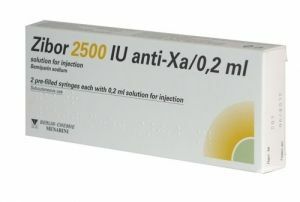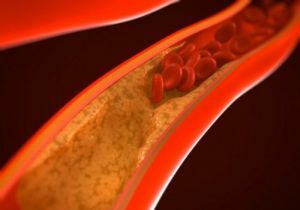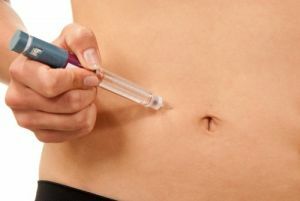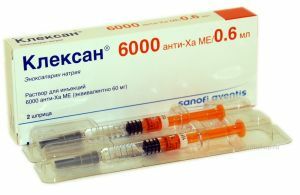 Ciabor refers to anticoagulants of direct action for subcutaneous administration. The active substance of the drug is sodium beimiparin, which is a low molecular weight heparin obtained from the mucous membrane of pigs.
Ciabor refers to anticoagulants of direct action for subcutaneous administration. The active substance of the drug is sodium beimiparin, which is a low molecular weight heparin obtained from the mucous membrane of pigs.
Today on sale you can find two forms of the drug Cibor 2500 and Cibor 3500, which differ in the dosage of the active substance.
The drug is available as a colorless or light yellow transparent solution for parenteral administration. The medicine is sold in ready syringes from borosilicate glass with a volume of 0.5 ml. For 2, 10, 30 and 100 pieces in one package.
Contents
- Pharmacokinetic properties and pharmacodynamics
- Scope
- Contraindications to prescription
- Purpose of medication for special categories of citizens
- Undesirable effects and cases of overdose
- Scheme of therapy
- Pharmaceutical compatibility
- Physician's review of Tsibor: which makes the whole
- fungi Word to patient
- Storage and dispensing conditions from the pharmacy
Pharmacokinetic properties and pharmacodynamics
Bemiparin sodium enhances the antiviral effectitrombin III to the active form of the Stewart-Prower factor, thereby achieving an anticoagulant effect. At the same time, the drug has a moderate hemorrhagic effect.
If the recommended regimen is followed, the drug does not cause a significant increase in clotting time.
The active substance is rapidly absorbed by subcutaneous injection. Bioavailability of the drug is 96%.The maximum therapeutic effect is observed after 2-3 hours after the administration of the drug. It is not known whether the active substance is metabolized in the body, whether it binds to proteins.
The half-life period lasts from 5 to 6 hours, so the drug is administered 1 time per day.
Scope
In which pathological conditions drug is prescribed: 
- is prescribed for the prevention of thromboembolism :
- for the therapy of patients with susceptibility to thrombus formation ;
- for the support of patients for orthopedic and general surgical interventions .
In addition, the drug is used to prevent coagulation in the circulatory system during hemodialysis.
Contraindications to the prescription of
Treatment with this drug should be discarded if the following conditions are observed:
- immunologic thrombocytopenia, provoked by heparin therapy;
- problems with blood coagulability;
- consumption coagulopathy developed against a background of thrombocytopenia, which was caused by heparin;
- severe liver and pancreatic pathology;
- individual intolerance;
- hypersensitivity to heparin;
- disease, in which there is a high risk of bleeding, such as intracerebral haemorrhage, peptic ulcer in the exacerbation phase, cerebral aneurysm, neoplasms of the brain;
- trauma and surgery of the central nervous system, vision and hearing;
- endocarditis.
The drug should be given with caution to patients if there is:
- uncontrolled high blood pressure;
- kidney stones;
- peptic ulcer of the stomach and 12-типерстной of a gut in the anamnesis;
- lumbar puncture;
- spinal and epidural anesthesia;
- renal and hepatic insufficiency;
- diseases of retina and iris of the eye.
Prescribing medicines to specific categories of citizens
 Currently, it is not known whether the active substance penetrates the placenta, therefore, in pregnancy, Cibor is appointed with caution. In experiments on animals, there was no teratogenic effect.
Currently, it is not known whether the active substance penetrates the placenta, therefore, in pregnancy, Cibor is appointed with caution. In experiments on animals, there was no teratogenic effect.
It is also not known whether the active principle is released through the mammary glands, so it is advisable to transfer the infant to artificial feeding during the treatment.
The drug should not be prescribed to patients under 18 years of age, as there is no data on the safety of use of the medication in this age group.
Elderly medication is prescribed as usual. In patients with renal or hepatic insufficiency treatment is carried out with caution.
The use of this drug should be abandoned for the treatment of patients with severe impairment of liver function.
Undesirable effects and cases of overdose
The following negative reactions may occur on the background of therapy:
- bleeding;
- thrombocytopenia;
- hematoma of the spinal cord, which can cause paralysis;

- nausea;
- vomiting;
- increase in hepatic enzymes;
- allergy;
- pressure reduction;
- osteoporosis;
- at the injection site can hemorrhage, bruising, pain and necrosis of the skin.
In case of an overdose, a hemorrhagic syndrome may appear. If as a result of an overdose increases the risk of thrombosis, the patient is prescribed intravenous protamine sulfate. In the case of minor bleeding, no treatment is performed.
Scheme of therapy
When performing general surgical procedures to reduce the risk of venous thromboembolism, the drug is administered subcutaneously at a dosage of 2500 IU 2 hours before or 6 hours after the completion of the surgical procedure.
Then the drug is prescribed 1 time per day. Duration of treatment is selected individually: until the probability of thrombosis is eliminated or until the patient is allowed to walk. At least the course of therapy is 1 week.
 When performing orthopedic operations, the drug is prescribed exactly the same way, but the dosage should be 3500 IU.
When performing orthopedic operations, the drug is prescribed exactly the same way, but the dosage should be 3500 IU.
The drug is administered subcutaneously in the anterolateral area of the abdomen or in the posterolateral region of the lumbar region. Each injection is done alternately from the right and left sides.
To prevent blood clotting in the system of artificial circulation during hemodialysis, the duration of which is not more than 4 hours, in the absence of bleeding, before starting the procedure, the drug is injected single-handedly bolus into the arterial bed.
For patients weighing a maximum of 60 kg, the drug is administered at a dosage of 2500 IU, the remaining patients - 3500 IU.
How to correctly inject in the abdomen:
Pharmaceutical compatibility
The drug is undesirable to be used simultaneously with non-steroidal anti-inflammatory drugs, anticoagulants, oral glucocorticosteroids, platelet aggregation inhibitors, as their combination increases the risk of bleeding.
If parallel assignment can not be avoided, then you need to carefully monitor the patient's well-being.
Since simultaneous administration of heparin and nitroglycerin for parenteral administration there is a decrease in the effect of anticoagulant, then when sodium beemiparin is used, a decrease in its effectiveness is possible.
Medical review on Tsibor: because of what all the fuss-
We learned the opinion of a surgeon about this medication, it's really interesting.
It should be remembered that the drug can not be administered intramuscularly. Moreover, because of the risk of developing bruises against the background of Cibore therapy, it is necessary to avoid prescribing other drugs for intramuscular use.
An active substance can inhibit the production of aldosterone by the adrenal glands, resulting in increased risk of hyperkalemia, especially in patients with diabetes mellitus, chronic renal failure, metabolic acidosis, taking potassium-sparing diuretics or potassium preparations.
To prevent this, it is necessary to constantly monitor the level of electrolytes in patients at risk. It is also necessary to check the concentration of thrombocytes throughout the entire treatment so as not to miss the development of thrombocytopenia.
If the platelet count is 2 times lower than normal, the drug is canceled and an alternative treatment is prescribed. Therapy is immediately withdrawn if there is a necrosis of the skin at the injection site.
Caution should be exercised when performing epidural or spinal anesthesia. The patient should be informed about the signs of neurologic disorders, namely, the appearance of pain in the back, problems in the work of the intestine and bladder, numbness of the extremities. At their development it is necessary to stop the introduction of the drug.
Denis Alexandrovich, surgeon, experience 10 years
The word to the patient
I now have II trimester of pregnancy, D-dimer was raised, the doctor appointed Tsibor, the prick is rather painful, although his needles are sharper than Kleksan's, but the place after the injection has a long sore. But analyzes in norm or rate.
Maria
Storage and dispensing conditions from the pharmacy
The price of the drug Cibor depends on the amount of active substance, and in the dosage 2500 starts from 3000 rubles, in 3500 from 3800 rubles and above.
The drug is banned for OTC.Store pricks at a temperature of no higher than 30 degrees, not allowing it to freeze.
Today you can not buy a full analogue of Cibor injections, but the pharmaceutical industry produces medicines with a similar  mechanism of action, among them:
mechanism of action, among them:
- Aksparin;
- Clexan;
- Novaparin;
- Flax.
The analogue should be chosen by a specialist, since not all low molecular weight heparins are interchangeable.
